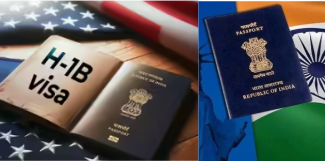– Arshad Shaikh
For decades the H1B visa has been a shining hope in countless Indian homes. It wasn’t just an immigration document. It was a ticket to social advancement. It was a pass to the American middle class and the golden age of the Indian success story. The H1B visa literally became the talk of the town. Students from every engineering campus, every coaching class and every WhatsApp group dreamt of crossing that magical bridge that takes you from Hyderabad or Indore straight to California or Texas or New Jersey.
But the question is whether this bridge truly leads to freedom or does it lead us to a new land of dependence where our destiny changes every four years with the stroke of a new American President. The recent announcement by the Trump administration that the H-1B application fee would be raised to $100,000 made the fragility of this bridge clear.
Benefits
At an individual level the pros of the H1B visa are quite attractive. The lives of millions of Indians were transformed by this visa. Higher salaries provided a sense of financial security at home. Apartments were rented in better neighbourhoods. Children had the opportunity to study in American schools and then in prestigious universities.
The presence of Indian names in global projects and tech conferences boosted the confidence of an entire generation. A significant portion of earnings returned to India every month in the form of remittances. These funds then supported countless dreams such as caring for elderly parents or paying for home renovations in smaller towns or educating siblings. In 2024 India received over $118 billion in remittances; more than a third of which came from the United States. Economically the benefits of H-1B are immediate and clear.
Remittances support the balance of payments and boost consumption among the urban middle class. Demand is generated in sectors like real estate or education or healthcare. India’s image as a global repository of technical skills is strengthened. Cities like Bengaluru and Hyderabad become hubs of innovation and services on the global map. Networks are forged between Indian and multinational companies helping our companies understand the language of the international marketplace. It also paves the way for start-up investment and tech transfer.
All that glitters – not gold
But this light is fleeting. H-1B holders often live in legal uncertainty. If they have a job today, their visa might be extended tomorrow. But no one knows when the path to a green card will open. Rules constantly change and immigration queues sometimes flow like a fast-moving river. Every major life decision like buying a house or deciding on a school for their children or taking a new career leap is linked to an invisible visa countdown.
At the social level too, there is this constant uncertainty. You work and pay taxes and contribute to innovation but you don’t receive the full scope of civil rights. A simple HR email can announce that the job is over. In that moment the entire family is reduced to a suitcase. The children return from school in California and try to adapt to the curriculum of Lucknow or Indore or Pune. The language and curriculum and friends suddenly change. At that moment the American dream seems to fade and the shock of returning becomes a tangible reality.
But the disadvantages are also significant. Brain drain is the most serious problem. The most trained minds work abroad. Their energy is not channelled into developing Indian institutions. This weakens the foundation of leadership and innovation.
Another disadvantage is that changes in US policy immediately impact the shares of Indian companies. Investor sentiment is shaken and the market becomes volatile.
Third, the direction of education is changing. Universities are preparing students to work abroad, not in India. The dream is to go to Silicon Valley. The question is less often asked why Pune or Ahmedabad shouldn’t have their own innovation valley. The social imagination has become foreign-centric and local entrepreneurship is being left behind.
Political Impact: Visa as a Weapon
At the political level, the US uses H-1B not just as an immigration tool but as a weapon. Increasing fees or changing the lottery system or tightening compliance requirements are all couched in technical terms but their implications are political. The message is that the US has the demand and India has the supply. India often remains restrained on this front. This is because strategic relationships or defence cooperation or the Indo-Pacific Partnership and factors like the China factor all weigh heavily on diplomacy. But this is where the dilemma arises. Can a country that calls itself an emerging power not assertively defend the interests of its citizens?
India’s Short and Long -Term Options
What are the options available? It’s essential to think both short-term and long-term. In the short-term, India could enact policies that protect the country’s engineering market from migration. For example, companies that send large amounts of talent abroad could be taxed with the goal of supporting domestic skill development and research investment. Additional compliance or higher entry fees could be imposed for US consultants to work in India.
At the trade level tariffs could be raised on US products where domestic or Asian alternatives are available. Multilateral forums like the WTO could raise the issue that excessive visa fees constitute an unfair trade barrier. Long-term strategy will determine India’s direction. First market diversification must be achieved. The US is a large and important market but not the only one. Europe or East Asia or the Middle East offer numerous opportunities for India.
Second, a homegrown innovation-based economy must be built. “Make in India” and “Digital India” must be implemented not just as slogans but with a solid policy framework and financial support.
Third, investment must be made in education and research. University laboratories or fellowships and industry-supported projects must work together to create an environment where talent stays here rather than leaving.
Fourth, the definition of societal success must change. A hero is not just someone who earns a fat pay package in the US but also someone who builds a company solving a difficult problem in Bengaluru or puts a deep-tech start up in Kanpur on the global map.
Fifth, migration must be balanced. Tax incentives and financial support and a business-friendly environment can be provided to encourage Indians who have migrated back. Time to go “glocal” i.e. implement the integration of global and local considerations, by adapting global products, principles, or strategies to local conditions and cultures.




